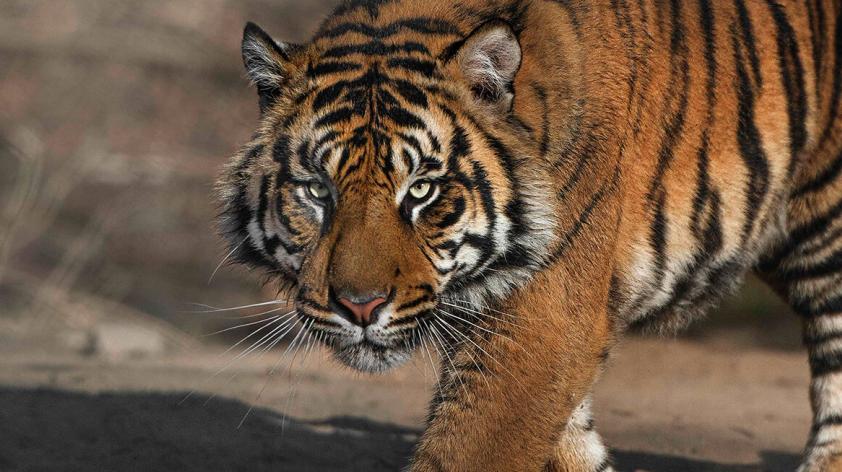
A new perspective on carcass feeding as enrichment for apex predators
As a master’s student in Miami University’s Advanced Inquiry Program (partnered with San Diego Zoo Global), I had the amazing opportunity to travel to Belize on an Earth Expedition. I volunteered for two weeks at The Belize Zoo, which had an impressive nineteen jaguars! Most are part of the Problem Jaguar Rehabilitation Program, which formed in 2003 in response to rising conflict between farmers and jaguars preying on their livestock. The zoo collaborates with the Belize Government and U.S. Fish and Wildlife Service to trap and transfer problem jaguars to an offsite area, where they receive medical treatment and undergo behavior modification training to reduce stress and aggression (The Belize Zoo, n.d.). Once a jaguar becomes more receptive to humans, it is moved to a public enclosure to serve as an educational ambassador for the species or is sent to another zoological facility to increase the genetic diversity of other captive jaguar populations (The Belize Zoo, n.d.).
As a volunteer, I learned firsthand about the enrichment provided to enhance jaguar welfare and encourage natural predator behavior. I hid pieces of chicken in their enclosures to elicit foraging behavior and tied boxes full of meat to a tree branch for them to rip down with their powerful claws and jaws. While observing the jaguars, I pondered how keepers decide which enrichment items to provide for these high-profile apex predators.
Through communication with San Diego Zoo’s Enrichment Supervisor, Jessica Sheftel, I learned that SDZG’s enrichment program “focus[es] more on eliciting specific types of behavior than on the physical characteristics of the enrichment objects” (J. Sheftel, personal communication, November 19, 2016). While the physical characteristics of enrichment might play a lesser role in the context of animal welfare, they could influence how zoo guests react to observing interactions with such items. I wondered, might guests’ attitudes toward a predator species be affected when they see it ripping apart an animal carcass? This question is worth considering because if guests negatively perceive predators due to the enrichment provided, that would go against a zoo’s educational mission to inspire passion for nature and a desire to aid in species conservation.
Several studies have investigated how guests perceive the use of different types of enrichment, but they primarily focus on teenagers and adults (Cottle, Tamir Hyseni, Bühler, & Lindemann-Matthies, 2010; Roth, 2015). Although guests in these studies expressed more positive than negative attitudes toward carcass feeding, I was curious whether the same would hold true for a younger demographic. Since Tiger Trail at the Safari Park draws guests of all ages, I sought to answer the question: Do some types of enrichment have a more positive or negative impact on children’s attitudes toward tigers?
I knew that finding child participants (and willing adult guardians) to complete questionnaires upon arrival and departure from Tiger Trail would be a challenge; I also could not control which types of enrichment were provided on any given day. Instead, I used online videos to bring tigers to the children. With permission from teachers at an elementary school in northern San Diego County, I gave a presentation about tiger conservation to four classrooms of eight to ten year old students. Every classroom saw the same presentation, with one key difference: two classrooms saw a video of a tiger interacting with a plastic Boomer ball, while the other two classrooms saw a video of a tiger interacting with a whole rabbit carcass. Teachers administered questionnaires before and after the presentation, in which students rated how much they agreed/disagreed with seven statements including “I like tigers and want to learn more about them,” and “Tigers are mean because they kill other animals.” How strongly a student agreed/disagreed with these statements was translated into an Attitude Score based on whether the statement reflected positive or negative feelings about tigers.
I discovered that regardless of which video students saw, their reported feelings toward tigers were significantly more positive after seeing the presentation than beforehand. This suggests that, at least for this age group, seeing a tiger with a rabbit carcass does not take away from a positive conservation message. In fact, enrichment that elicits natural predatory behavior in animals under human care may serve not only as a health benefit for the animals, but also as a vital learning tool for guests. Although more research is needed to see whether younger children feel similarly about this realistic, albeit gory, type of enrichment, the consensus based on research with youth seems to be: Let them eat carcass!
References:
Cottle, L., Tamir, D., Hyseni, M., Bühler, D., & Lindemann-Matthies, P. (2010). Feeding live prey to zoo animals: response of zoo visitors in Switzerland. Zoo Biology, 29(3), 344-350.
Roth, E. K. (2015). Food for Thought: Assessing Visitor Comfort and Attitudes toward Carcass Feeding at the ABQ BioPark Zoo (Doctoral dissertation, University of Washington).
The Belize Zoo. (n.d.). Problem Jaguar Rehabilitation Program. Retrieved from http://www.belizezoo.org/conservation/problem-jaguar-rehabilitation-program.html













